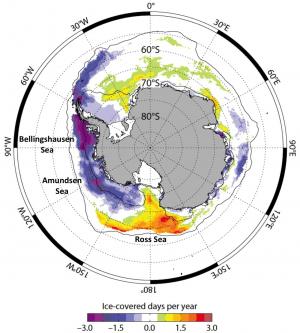Environment & Energy
Related: About this forumRealClimate - Clarity On Antarctic Sea Ice
I’ve always been a skeptic when it comes to Antarctic sea ice. I’m not referring here to the tiresome (and incorrect) claim that the expansion of sea ice around Antarctica somehow cancels out the dramatic losses of sea ice in the Arctic (NB: polar bears don’t really care if there is sea ice in Antarctica or not). Rather, I’m referring to the idea that the observation of Antarctic sea ice expansion represents a major conundrum in our understanding of the climate system, something one hears even from knowledgeable commentators. In this post, I’ll try to provide some clarity on this subject, with some basic background and discussion of a couple of important recent papers.
In general, Antarctic sea ice forms near the coastline, where upwelling waters cool to the atmosphere. It melts when the winds and currents push it into areas of warmer water to the north. In the summer, it melts pretty much all the way back to the coast. An efficient way to form lots of Antarctic sea ice during the autumn growth season is to have strong winds that push the ice away from the coastline. Pushing sea ice away leaves open water that can lose heat to the atmosphere, creating more sea ice. The persistent circumpolar westerlies are critical in pushing ice toward the north, into warmer waters. (Owing to the Coriolis effect, westerly winds cause northward-flowing surface ocean currents in the Southern Hemisphere).
The importance of the winds in controlling Antarctic sea ice leads to the obvious idea that changing winds can explain the increase that has been observed over the last several decades. There has indeed been a substantial increase in the circumpolar westerlies; this is very well established from observations and is associated with the oft-discussed increase in the “Southern Annular Mode” (SAM) index2. Averaged over the year, the SAM index has increased nearly monotonically since the 1970s (e.g., Marshall et al., 2003). This has led to a fairly simple logic in explaining the recent sea ice increase: the westerly winds have increased, so sea ice has increased too. Furthermore, there is good evidence that the increasing westerlies are a response to anthropogenic climate forcing from CO2 and other greenhouse gas increases in the troposphere, along with ozone declines in the stratosphere (Thompson and Solomon, 2002; Thompson et al., 2011). This would suggest that the observed increase in Antarctic sea ice extent is anthropogenic in origin, just like the Arctic sea ice decline, but for very different reasons. In short, reduced ozone in the stratosphere, and increased CO2 in the troposphere — both climate forcings that are unequivocally anthropogenic — cause increased westerly winds, which cause Antarctic sea ice to expand.
Of course, it’s not that simple. For one thing, the average increase of Antarctic sea ice is actually a small number that is the difference of two big numbers — modest increases over a large area, mostly in the Eastern Hemisphere, and very large decreases over a smaller area in the Western Hemisphere. The map below, showing change in the length of the sea ice season over the last 30 years, illustrates this point well. In spite of the average increase, there are very rapid declines in the Bellingshausen and Amundsen Seas, comparable to sea ice declines in the Arctic. Furthermore, the only season is which there is a significant trend in the westerlies is austral summer. There is a weak positive trend in fall, but both spring and winter show no trend; the SAM trends in these seasons may even be slightly negative, depending on which data are used (Ding et al., 2012). Yet the pattern of sea ice change is quite similar in all seasons: decreasing along the Pacific coast of West Antarctica, and increasing around most of East Antarctica, and in the Ross and Weddell Seas.

Trend in the length of the sea ice season, 1979-2010. Blue and purple areas show areas where sea ice is declining, orange and red where it is increasing. Source: Maksym et al., 2012
EDIT
http://www.realclimate.org/index.php/archives/2014/12/clarity-on-antarctic-sea-ice/
Gothmog
(145,242 posts)It is a great source of good information